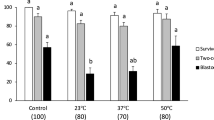Abstract
The failure of complex mammalian organs, such as the kidney, to function following freezing to low temperatures is thought to be due largely to mechanical disruption of the intercellular architecture by the formation of extracellular ice1–5. Classical approaches to the avoidance of ice formation through the imposition of ultra-rapid cooling and warming rates6–8 or by gradual depression of the equilibrium freezing point during cooling to −80 °C9–13 have not been adequate. An alternative approach14–16 relies on the ability of highly concentrated aqueous solutions of cryoprotective agents to supercool to very low temperatures. At sufficiently low temperatures, these solutions become so viscous that they solidify without the formation of ice, a process termed vitrification. When embryo suspensions are cryopreserved using conventional procedures, this supercooling behaviour allows intracellular vitrification, even in the presence of extracellular ice17–20. We have therefore used mouse embryos to examine the feasibility of obtaining high survival following vitrification of both the intra- and extracellular solutions and report here that in properly controlled conditions embryos seem to survive in high proportions after cryopreservation in the absence of ice.
Similar content being viewed by others
References
Pegg, D. E., Jacobsen, I. A., Armitage, W. J. & Taylor, M. J. in Organ Preservation Vol. 2 (eds Pegg, D. E. & Jacobsen, I. A.) 132–144 (Churchill Livingstone, Edinburgh, 1979).
Fahy, G. M. Cryobiology 18, 550–570 (1981).
Pegg, D. E. & Diaper, M. P. in Organ Preservation, Basic and Applied Aspects (eds Pegg, D. E., Jacobsen, I. A. & Halasz, N. A.) 389–393 (MTP, Lancaster, 1982).
Hunt, C. J. Cryobiology 21, 385–402 (1984).
Jacobsen, I. A. & Pegg, D. E. Cryobiology 21, 377–384 (1984).
Luyet, B. J. Biodynamica 1, P. 29, 1–14 (1937).
Luyet, B. J. & Gehenio, P. M. Life and Death at Low Temperatures (Biodynamica, Normandy, 1940).
Rapatz, G. & Luyet, B. Biodynamica 10, 193–210 (1968).
Farrant, J. Nature 205, 1284–1287 (1965).
Elford, B. C. & Walter, C. A. Nature 236, 58–60 (1972).
Elford, B. C. & Walter, C. A. Cryobiology 9, 82–100 (1972).
Fahy, G. M. Cryobiology 17, 371–388 (1980).
Kemp, E., Clark, P. B., Anderson, C. K. & Parsons, F. M. Proc. Eur. Dialysis Transplant Ass. 3, 236–240 (1966).
Fahy, G. M. & Hirsch, A. in Organ Preservation, Basic and Applied Aspects (eds Pegg, D. E., Jacobsen, I. A. & Halasz, N. A.) 399–404 (MTP, Lancaster, 1982).
MacFarlane, D. R., Angell, C. A. & Fahy, G. M. Cryo-Letters 2, 353–358 (1981).
Fahy, G. M., MacFarlane, D. R., Angell, C. A. & Meryman, H. T. Cryobiology 21, 407–426 (1984).
Leibo, S. P., McGrath, J. J. & Cravalho, E. G. Cryobiology 15, 257–271 (1978).
Rall, W. F., Reid, D. S. & Farrant, J. Nature 286, 511–514 (1980).
Rall, W. F. in Frozen Storage of Laboratory Animals (ed. Zeilmaker, G. H.) 33–44 (Fischer, New York, 1981).
Rall, W. F., Reid, D. S. & Polge, C. Cryobiology 21, 106–121 (1984).
Boutron, P., Delage, D., Rousit, B. & Korber, C. Cryobiology 19, 550–564 (1982).
Rasmussen, D. & Luyet, B. Biodynamica 11, 33–44 (1970).
Rasmussen, D. H. & MacKenzie, A. P. Nature 220, 1315–1317 (1968).
Angell, C. A. & Sare, E. J. Cryo-Letters 1, 257–260 (1980).
MacKenzie, A. P. in Water Relations of Foods (ed. Duckworth, R. B.) 477–503 (Academic, London, 1975).
Takahashi, T. et al. Cryobiology (submitted).
Burdette, E. C. in Organ Preservation for Transplantation (eds Karow, A. M. Jr & Pegg, D. E.) 213–259 (Dekker, New York, 1981).
Burdette, E. C., Wiggins, S., Brown, R. & Karow, A. M. Jr Cryobiology 17, 393–402 (1980).
Rall, W. F., Mazur, P. & McGrath, J. J. Biophys. J. 41, 1–12 (1983).
Dulbecco, R. & Vogt, M. J. exp. Med. 99, 167–182 (1954).
Whittingham, D. G. Nature 233, 125–126 (1971).
Brinster, R. L. in Growth, Nutrition, and Metabolism of Cells in Culture (eds Rothblat, G. H. & Cristofalo, V. J.) 251–286 (Academic, New York, 1972).
Author information
Authors and Affiliations
Rights and permissions
About this article
Cite this article
Rall, W., Fahy, G. Ice-free cryopreservation of mouse embryos at −196 °C by vitrification. Nature 313, 573–575 (1985). https://doi.org/10.1038/313573a0
Received:
Accepted:
Published:
Issue Date:
DOI: https://doi.org/10.1038/313573a0
- Springer Nature Limited
This article is cited by
-
Advanced cryopreservation engineering strategies: the critical step to utilize stem cell products
Cell Regeneration (2023)
-
Effect of blastocyst shrinkage on assisted reproductive outcomes: a retrospective cohort study describing a new morphological evaluation of blastocyst pre-vitrification and post-warming
Journal of Ovarian Research (2023)
-
Sound waves for solving the problem of recrystallization in cryopreservation
Scientific Reports (2023)
-
Cryopreservation of tissues by slow-freezing using an emerging zwitterionic cryoprotectant
Scientific Reports (2023)
-
Cryopreservation of rat embryos at all developmental stages by small-volume vitrification procedure and rapid warming in cryotubes
Scientific Reports (2023)





